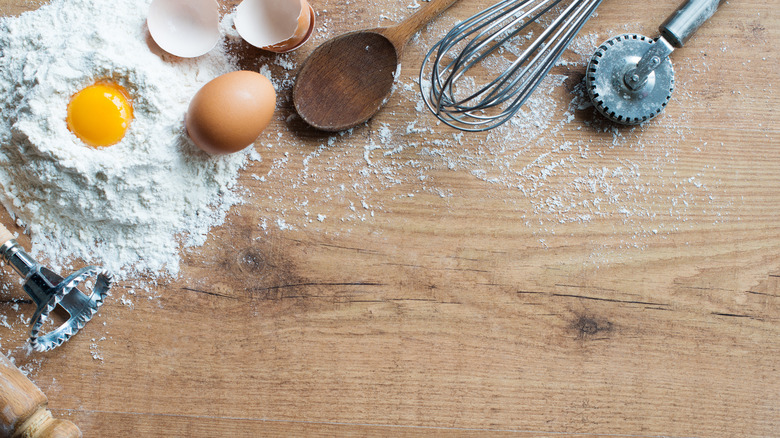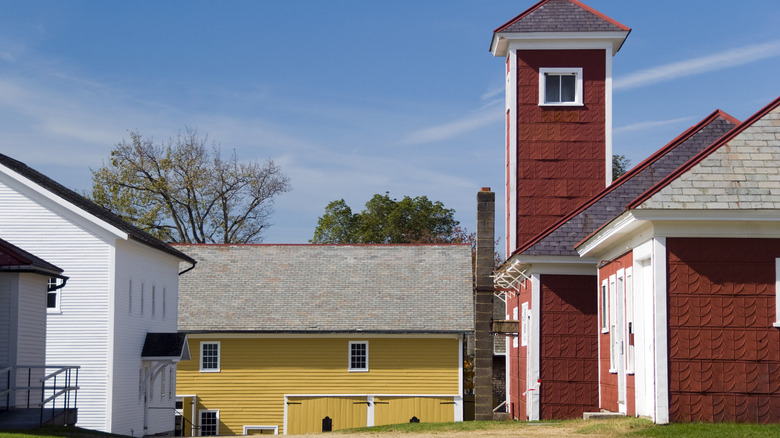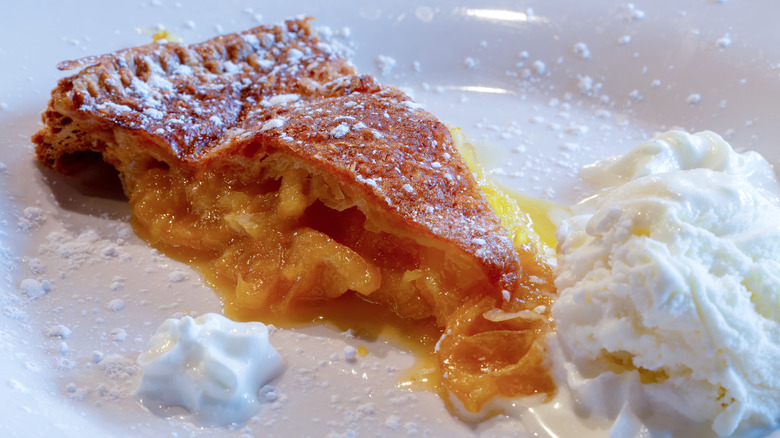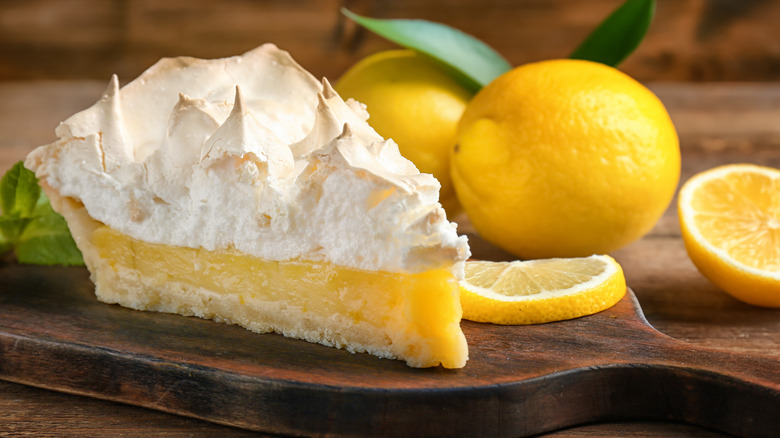The Religious 18th Century Origins Of Shaker Lemon Pie
Across the northeast and midwestern United States, you'll find living history museums dedicated to preserving and educating visitors on the lives and legacy of the Shakers. These museums, developed from the remains of once-thriving villages, are populated by interpreters and docents in historical dress who act out what was once the daily practices of those living in a Shaker community. All of the woodworking, quilting, cooking, and worshiping practices are on display. You can even bring home a bit of the Shaker diet with historical fresh baked goods, herbal mixes, and syrups, most of which are made on site or procured from partnering villages.
If you've heard of the Shakers at all, you're probably most familiar with their furniture. The beautiful symmetry, balance, precision, and exacting attention to detail on pieces as seemingly mundane as a basket or rocking chair offer an insight into this important, yet diminished utopian religious movement. The same simplicity and rigor given to furniture making was extended elsewhere in Shaker life, including their diet.
As the Shakers had the foresight to write a good number of their recipes down, a great many live on with some of the most well-known and sought-after recipes being for Shaker breads and pies. One such pie, known simultaneously as Shaker lemon pie or Ohio lemon pie (as it's often attributed to the Ohio Shaker community, specifically), is a unique yet simple dish that oozes with the religious philosophy of this enigmatic community.
Who are the Shakers?
Before jumping into all the pie details, it's important to learn the history of the Shakers. According to the Sabbathday Lake Shaker Village, the Shakers first appeared in England in the 1740s, as an offshoot of the Quakers, another protestant Christian denomination. A small group of members from the Society moved to America in 1774, on the eve of the War of Independence. Because of their pacifism and what some called eccentric religious practices, the Shakers remained quiet and unobtrusive until the fighting was finished. Once the new nation was formed, the Shakers began to expand.
Intentionally forgoing what they considered to be the moral corruption of city life, the Shakers built rural communities across the East Coast and even ventured as far west as Ohio and Kentucky. Similar to, though not to be confused with, The Amish, Shakers favored plain, simple clothing, and strived to form a Utopian Society dedicated to the work of God. However, their rule of complete celibacy eventually caused Shaker communities to all but vanish. The only active community left in the nation is Sabbathday Lake Shaker Village in New Gloucester, Maine, populated by the only two Shakers remaining in the world, according to Smithsonian Magazine.
At their height, these Shaker communities were home to hundreds of believers. Union Hill in Ohio was home to nearly 600. With all those mouths to feed, it's no wonder the Shaker Sisters who ran the kitchens practiced such simplicity and economy. If a stock of lemons arrived for pie, there was absolutely no way any of the fruit would go to waste.
Religion, thrift, and lemons
Shaker lemon pie, or Ohio lemon pie, is said to have been developed in the early 19th century, according to Sue Hubbell's "From Here to There and Back Again." The Shakers were at their most prominent during the century between the American Revolution and the dawn of the 20th century, with communities being built across the fledgling nation. Feeding these communities was no laughing matter. A Shaker kitchen was a combination of economy and innovation, and outfitted with every convenience a 19th-century housewife could think to need. The Shaker Sisters, who were in charge of all meals, executed their duties with precision and efficiency, turning out fruit-filled pies, bread, and soups multiple times a day. These exacting efforts were in direct relation to the Society's religious practices.
The Shaker motto — "Hands to work,hearts to God" — is taken with utter seriousness. When it comes to food, a Shakers' view is to always keep things simple. Ironically, this also meant putting in as much effort as you could to make the meal as good as it could possibly be. In the case of the lemon pie, it was not developed simply for the sake of it. To a Shaker, anything they produce must be an extension of their commitment to both work and God.
As a result, Shaker lemon pie was born from this creed. Using the whole lemon was an economic decision; as a matter of principle, nothing would go to waste.
How to make Shaker lemon pie
Shaker lemon pie calls for very few ingredients. One pie requires nothing more than enough pastry to hold and cover the filling, which is no more than two lemons, two cups of sugar, and four eggs. We grant that the idea of using the whole lemon seems like a strange notion to us today, but it makes preparing this pie even easier and is a frugal way to cut down on waste.
For the filling, the lemons are sliced thin and any seeds are removed. Sugar is then added and this mixture sits out for several hours or, ideally, overnight, allowing maceration to occur. The sugar breaks down the lemons into something between a paste and a pulp and mixes with the acid to remove a fair amount of bitterness from the fruit. Once macerated, the beaten eggs are added to the mixture.
The base crust is prepared in a standard 9-inch pie pan. Once the filling goes in, the top crust is laid on, the edges are crimped and the pie goes into the oven. After it's baked, the pie then needs to cool on a wire rack before it can be sliced. The cooling time allows for the lemon filling to set, making the pie much easier to cut.
Not your average lemon pie
If you're a fan of lemon-y desserts, then you're probably more than familiar with lemon curd. This delicious, bittersweet concoction is basically a lemon pudding and is the base for many lemon pies. The most famous example of a lemon curd pie is probably lemon meringue pie, while Shaker lemon pie filling is looser — somewhere between a curd and a marmalade. Although these two lemon pies share many similarities, the values they embody couldn't be more different.
Another lasting favorite of the 19th century, lemon meringue pie is a delicious combination of shortcrust pastry and lemon curd topped with a silky sweet pillow of beautifully light meringue that rises like mountain peaks. Favored among an upscale crowd for its decadence, lemon meringue pie was a favorite in city circles, especially in Philadelphia, where it originated. The lemon juice used for the curd, or custard as it was called previously, is seen as the most valuable component of the fruit, as it keeps the mixture smooth while adding as much concentrated lemon flavor as possible.
In comparison, when we look at Shaker lemon pie, we see the polar opposite of this selective philosophy. Using only the juice would be considered a waste to 19th-century Shakers. Thus, as a way of getting the most out of an ingredient, everything was put to use. The peel, pith, and inner flesh provide a whole lemon experience without wasting any of the fruit. This leads to an overall more rustic eating experience, which suited the Shakers quite well. For a society that never sought favor with the greater culture, the Shakers have provided an enduring legacy of structured simplicity.




